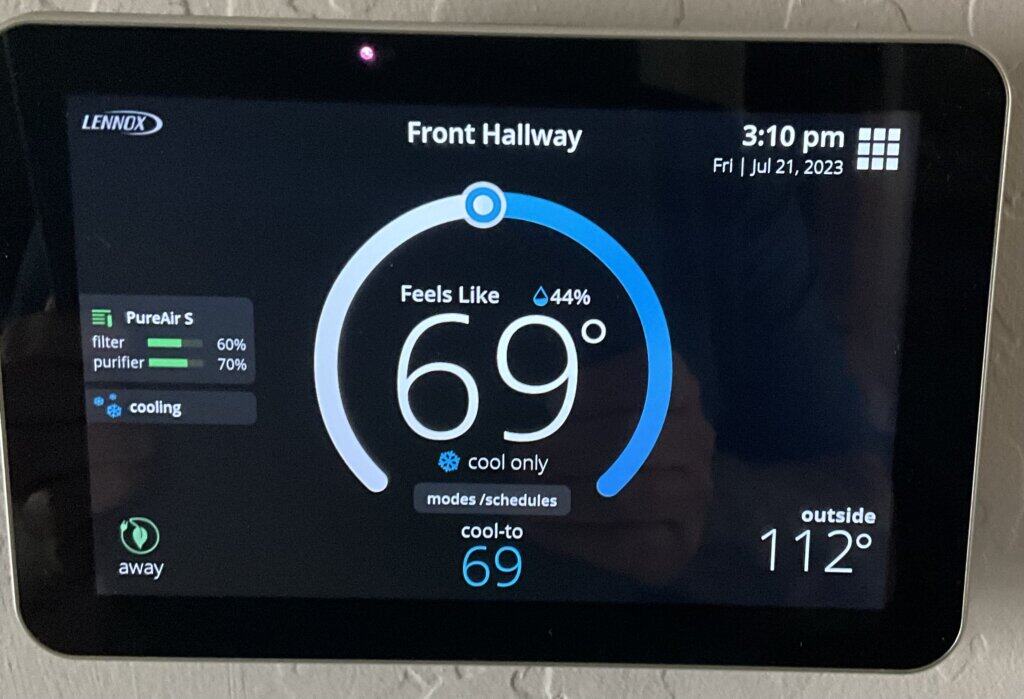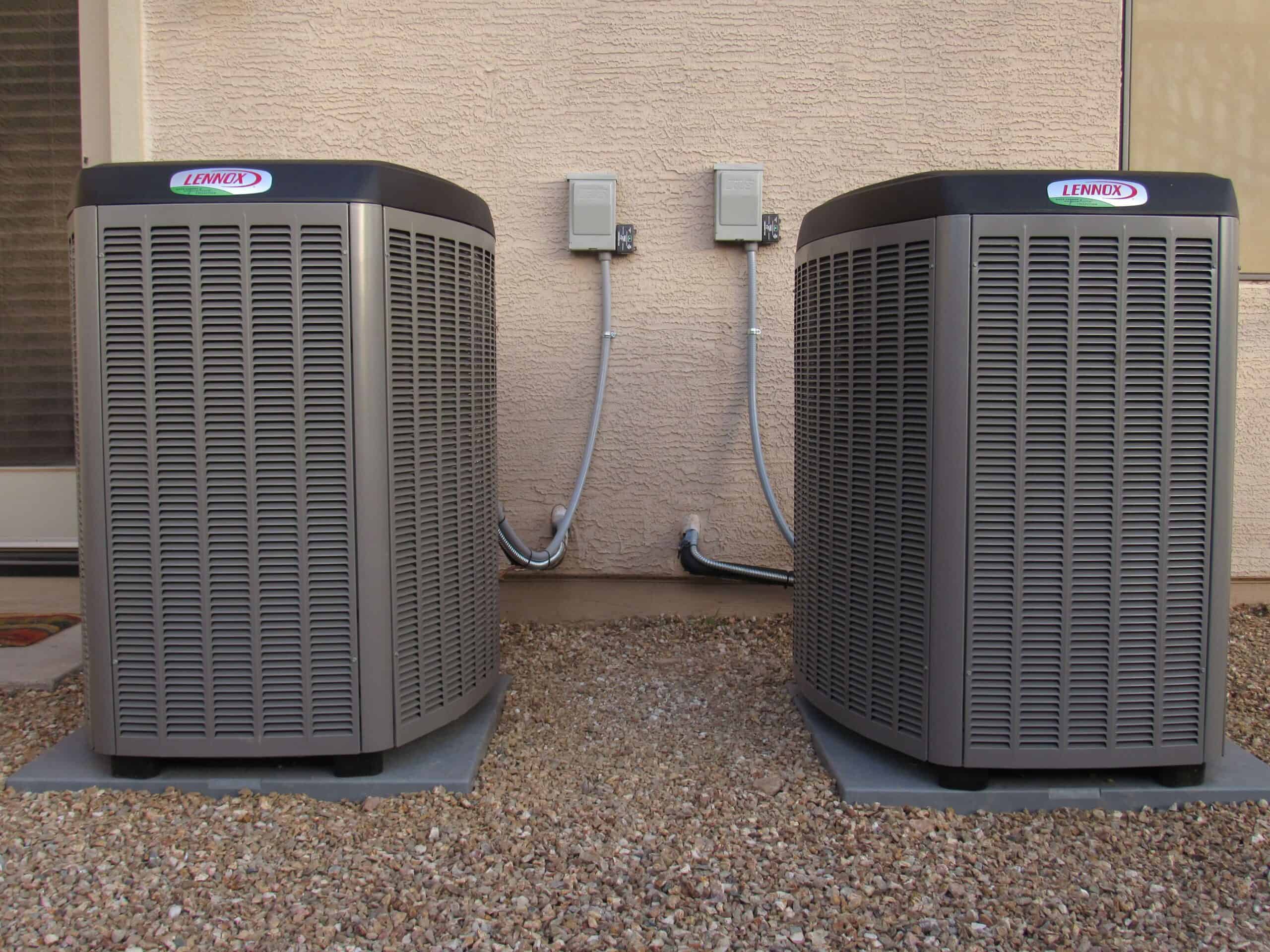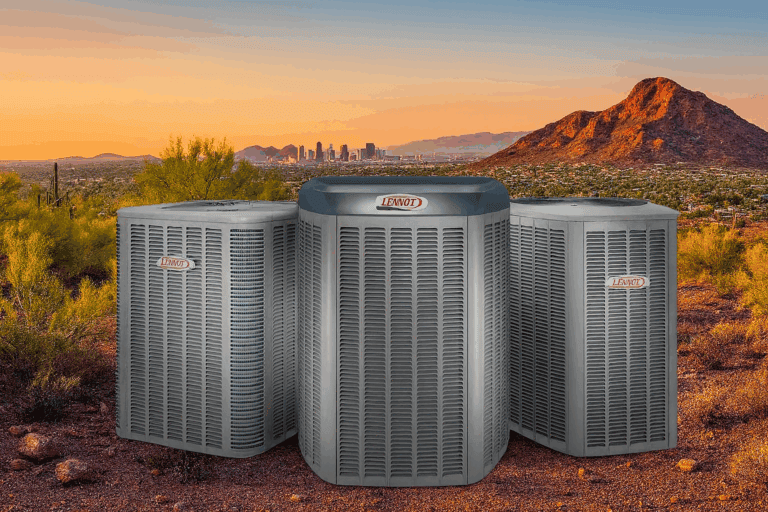An unbiased review of the Lennox Variable Speed Air Conditioner from a homeowners viewpoint (me), and a HVAC contractor’s standpoint (also me). This follow up review covers the good, bad, and ugly about these units after installing them in my own home 6-years ago.
TL;DR (Too Long, Didn’t Read) Quick Summary
Wondering how Lennox variable speed A/C units hold up after 6 brutal Phoenix summers? Here’s the short version:
- 🌡️ Comfort: Dead-on precise. Set 72°, stay 72°.
- 🤫 Noise: Whisper-quiet, even at 118° with both units outside my bedroom.
- 🏗️ Build Quality: Still solid after 6 Arizona summers.
- ⚙️ Reliability: One major refrigerant failure — but thermostat/Smart Hub issues = 7 more failures.
- 💸 The Ugly: 4 thermostat failures + 3 hub failures in 6 years.
- 🏆 Bottom Line: Rolls-Royce level comfort and performance… with Rolls-Royce costs (and quirks).
👉 Want the full story with charts, context, and a contractor’s perspective? Keep reading.
Out With York – In With Lennox
When I moved from Mesa to Gold Canyon, AZ almost six years ago, one of my first orders of business was replacing the two very noisy, builder-grade York air conditioners and furnaces I inherited.
I replaced them with two Lennox XC25 air conditioners, matched with Lennox SL280V natural gas furnaces.
Today’s equivalents are the Lennox SL28XCV (still R410a) and the Lennox SL25KCV (new R454b).
Why I Chose Lennox Variable Speed
If you’ve never read my blog or watched my reviews on our YouTube channel — shame on you! (Just kidding.) But here’s why this review matters:
I founded Magic Touch 28 years ago and have been an HVAC technician and installer for over 35 years. We’ve installed and repaired thousands of Lennox units across Phoenix, Chandler, Gilbert, and Scottsdale, but we also install Bosch, Gree, Trane/American Standard, Goodman/Amana, Daikin, Mitsubishi, Airtemp, and others.
When I picked a system for my own home, here was my checklist:
- It had to be a variable speed inverter compressor.
(See the chart below to understand why variable speed matters compared to single-stage and two-stage systems — the difference in comfort and efficiency is night and day in Arizona’s desert climate.) - It had to be ultra-efficient — not just for comfort, but also to help keep APS and SRP summer bills under control.
- The company had to have great tech support.
- Parts had to be readily available in Phoenix.
- It couldn’t be on our “Do Not Recommend” list (which changes year to year).
📊 Single Stage vs. Two Stage vs. Variable Speed
| Technology | Example in My Home | Year | Comfort | Noise | Energy Use | Takeaway |
|---|---|---|---|---|---|---|
| Single Stage | Trane XR13 (Mesa) | 2017 | ❌ Uneven temps, big swings | ❌ Loud on/off | ❌ Highest bills | Outdated, least comfortable. |
| Two Stage | Lennox LRP16 (Mesa) | 2017 | ✔️ Smoother comfort | ✔️ Quieter | ✔️ Lower bills | Noticeable step up. |
| Variable Speed | Lennox XC25 (Gold Canyon) | 2019 | ✅ Perfectly precise | ✅ Whisper quiet | ✅ Lowest bills | Game-changer. Not even close. |
Ultimately, two models checked all the boxes for me at the time:
- Lennox XC25
- Bosch IDS Premium
I chose Lennox because they offered straight A/C with an 80% AFUE furnace. Bosch was heat pump only, which would’ve meant converting. Not a deal-breaker (we recommend it all the time), but I stuck with gas.
👉 If I had to do it again today, I’d choose Bosch. The value is better, and after the thermostat issues I’ve lived with, the price gap matters.
👉 Important note: Magic Touch Mechanical sells multiple brands including Lennox, Bosch, American Standard, Mitsubishi, Goodman, Amana & Airtemp (and a few more depending on the application). I mention that so you know my reviews are completely unbiased. Frankly, I’m happy when someone chooses Magic Touch as their installer no matter what brand they choose!
The Good
1. Precise Comfort
Lennox advertises “the most precise comfort money can buy.” I agree. If I set 72°, my house is 72°. Not 73, not 71. Always spot on — even during a 118° Phoenix July heatwave.
2. It’s SO Quiet
I have a 5-ton and 4-ton XC25 right outside my bedroom windows. When both are running 100% during the hottest monsoon season nights, I can’t hear them.
3. Build Quality
After 6 Arizona summers, the cabinets still look great. No rattles (as long as screws are tightened periodically), no rust, and even the powder coat still shines.
4. Support & Parts
Whenever replacement parts were needed, availability in Phoenix-area supply houses was excellent and Lennox tech support was responsive.
The Bad
The Lennox S30 Thermostat
This thermostat started on my “Good” list. It’s feature-rich and great looking, but user experience has been frustrating.
- Wi-Fi Smart Hub issues: When the hub loses communication, sometimes you can’t operate the AC. The error screen blocks the manual controls. If you only have one system in your home, I can’t recommend it.
- Phantom purifier error: For 6 years, one thermostat has shown a “purifier error.” The purifier works fine, but Lennox support never solved it. Annoying on a $20K+ system.
- Breakdowns happen: This past summer I had a refrigerant circuit failure requiring a new expansion valve, filter drier, and refrigerant. That could happen to any brand, but worth noting.
👉 Other than that single major failure, my only “bad” has been thermostat-related. That’s impressive for units already at mid-life.

The Ugly
This one pains me, because I like Lennox as a company. Their support is excellent, and they’re innovative. But facts are facts:
- 4 thermostat failures in 6 years.
- 3 Smart Hub failures (one on one unit, two on the other).
- 8 failures in 6 years total.
When the thermostat or hub fails, the whole AC is down until you replace it. And you can only use their proprietary controls.
For homeowners in Mesa, Gilbert, or Scottsdale who only have a single AC system — that risk is even higher.
Summary & Final Advice
The precise comfort, whisper-quiet operation, and build quality of Lennox’s variable speed systems are undeniable. After 6 brutal Phoenix-area summers, I can say they’re impressive machines.
But the proprietary thermostat and hub are their Achilles’ heel. They’re expensive, fragile, and required.
✅ Quick Pros & Cons Snapshot
| Feature | Single Stage | Two Stage | Variable Speed |
|---|---|---|---|
| Comfort | ❌ Basic | ✔️ Better | ✅ Best |
| Noise | ❌ Loud | ✔️ Quieter | ✅ Whisper quiet |
| Efficiency | ❌ Lowest | ✔️ Moderate | ✅ Highest |
| Energy Bills | ❌ Highest | ✔️ Lower | ✅ Lowest |
| Technology | ❌ Oldest | ✔️ Solid step | ✅ State-of-the-art |
My Advice for Phoenix Homeowners
- If you’re a Rolls-Royce buyer in Phoenix or the East Valley and money is no object — the Lennox XC25/SL28XCV is still the Rolls.
- If you want BMW/Mercedes-level comfort and efficiency without the Rolls-Royce price tag — the Bosch IDS Premium is the smarter play.
- And unlike Lennox, Bosch lets you use a standard smart thermostat like an Ecobee or Nest.
👉 If I had to replace my systems in Gold Canyon today, I’d go Bosch IDS Premium — better value, fewer headaches, and still perfect for keeping APS and SRP bills under control during our 115°+ summers.
FAQ – Lennox Variable Speed Air Conditioner Review
Most variable speed systems, including Lennox, have an average lifespan of 10–15 years in Phoenix’s extreme desert climate. With meticulous maintenance, I’ve seen some reach 16–18 years. After 6 of the hottest summers on record in Gold Canyon, my XC25 units are still running strong with the exception of the issues discussed.
If money is no object and you want Rolls-Royce comfort, yes. But in my experience, homeowners in Mesa, Chandler, and Gilbert find Bosch IDS Premium variable speed systems a better bang for the buck.
No. Unfortunately, Lennox’s variable speed units require the proprietary Lennox S30 thermostat and Smart Hub. This is both a strength (integrated controls) and a weakness (expensive, failure-prone).
The XC25 was Lennox’s flagship variable speed A/C. It was replaced by the SL28XCV, which still uses R410a refrigerant. The SL25KCV is nearly identical but uses the new R454b refrigerant to meet upcoming EPA regulations.
Lennox delivers unmatched precision comfort and whisper-quiet operation. But Bosch IDS Premium delivers 99% of the comfort at a significantly lower price — and lets you use your preferred Wi-Fi thermostat (we recommend Ecobee Pro or Honeywell). Many Phoenix homeowners choose Bosch for the value.
Yes. With the exception of supply chain issues post-pandemic which was par for the course with every HVAC manufacturer, I’ve never had a problem sourcing Lennox parts in the Phoenix metro area. Their distribution network here is strong, and tech support has always been responsive.
Night and day. My two XC25 units (5-ton and 4-ton) sit outside my bedroom in Gold Canyon. Even at 100% capacity during a 118° July day, I can’t hear them running. Compared to older single-stage York and Trane units, it’s like going from a Harley to a Tesla. Hear it for yourself on our YouTube Channel: Listen to the Lennox XC25
Yes. Variable speed technology allows the system to run longer at lower speeds, maintaining steady temps with less energy. In Mesa, Chandler, and Gilbert homes I’ve seen, APS and SRP customers often save 20–30% compared to single-stage systems. I’ve seen a few extreme cases where the savings was close to 50% when coupled with other home improvements and ductwork improvements.
Not more maintenance, but proper maintenance is crucial. Annual coil cleanings, refrigerant checks, and filter changes are a must in Phoenix’s dust storms and monsoon season. Skipping maintenance will cut the life of any system in half here.
If you’re a “Rolls-Royce” buyer who values quiet, precision comfort, and doesn’t mind the premium cost — Lennox is a great choice. If you’re more of a “Mercedes/BMW” type and want comfort without the highest price tag, Bosch IDS Premium or similar may be a smarter choice for East Valley homeowners.
Yes. As these machines pack a lot of computer driven technology into the box, the argument can certainly be made that there are more components that can potentially act up or even downright fail. These high-tech components also come with a higher price tag to repair than “simpler” components.







